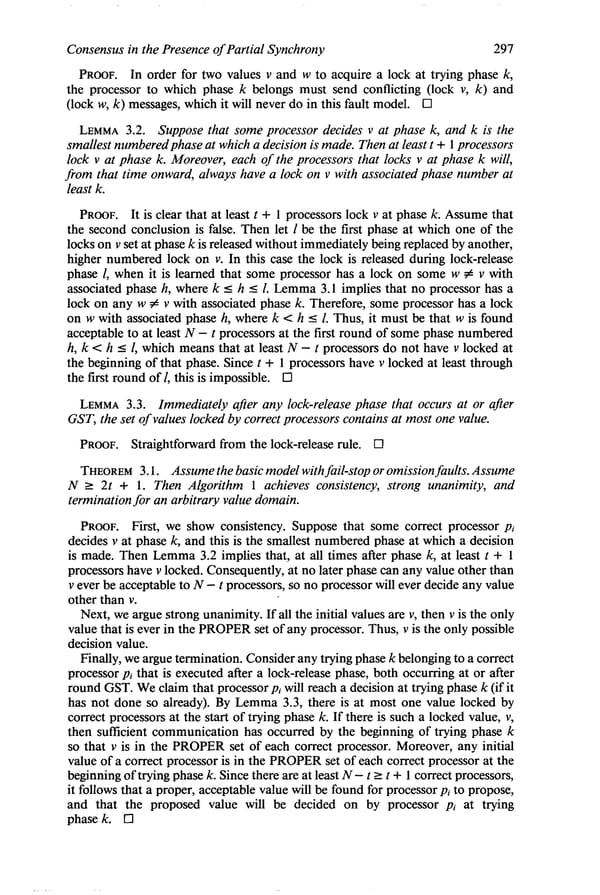Consensus in the Presence of Partial Synchrony 297 PROOF. In order for two values v and w to acquire a lock at trying phase k, the processor to which phase k belongs must send conflicting (lock v, k) and (lock w, k) messages, which it will never do in this fault model. Cl LEMMA 3.2. Suppose that some processor decides v at phase k, and k is the smallest numbered phase at which a decision is made. Then at least t + 1 processors lock v at phase k. Moreover, each of the processors that locks v at phase k will, from that time onward, always have a lock on v with associated phase number at least k. PROOF. It is clear that at least t + 1 processors lock v at phase k. Assume that the second conclusion is false. Then let 1 be the first phase at which one of the locks on v set at phase k is released without immediately being replaced by another, higher numbered lock on v. In this case the lock is released during lock-release phase 1, when it is learned that some processor has a lock on some w # v with associated phase h, where k 5 h I 1. Lemma 3.1 implies that no processor has a lock on any w # v with associated phase k. Therefore, some processor has a lock on w with associated phase h, where k < h 5 1. Thus, it must be that w is found acceptable to at least N - t processors at the first round of some phase numbered h, k c h 5 1, which means that at least N - t processors do not have v locked at the beginning of that phase. Since t + 1 processors have v locked at least through the first round of 1, this is impossible. Cl LEMMA 3.3. Immediately after any lock-release phase that occurs at or after GST, the set of values locked by correct processors contains at most one value. PROOF. Straightforward from the lock-release rule. 0 THEOREM 3.1. Assume the basic model with fail-stop or omission faults. Assume N 2 2t f 1. Then Algorithm 1 achieves consistency, strong unanimity, and termination for an arbitrary value domain. PROOF. First, we show consistency. Suppose that some correct processor pi decides v at phase k, and this is the smallest numbered phase at which a decision is made. Then Lemma 3.2 implies that, at all times after phase k, at least t + 1 processors have v locked. Consequently, at no later phase can any value other than v ever be acceptable to N - t processors, so no processor will ever decide any value other than v. Next, we argue strong unanimity. If all the initial values are v, then v is the only value that is ever in the PROPER set of any processor. Thus, v is the only possible decision value. Finally, we argue termination. Consider any trying phase k belonging to a correct processor pi that is executed after a lock-release phase, both occurring at or after round GST. We claim that processor pi will reach a decision at trying phase k (if it has not done so already). By Lemma 3.3, there is at most one value locked by correct processors at the start of trying phase k. If there is such a locked value, v, then sufficient communication has occurred by the beginning of trying phase k so that v is in the PROPER set of each correct processor. Moreover, any initial value of a correct processor is in the PROPER set of each correct processor at the beginning of trying phase k. Since there are at least N - t 2 t + 1 correct processors, it follows that a proper, acceptable value will be found for processor pi to propose, and that the proposed value will be decided on by processor pi at trying phase k. Cl
 Consensus in the Presence of Partial Synchrony Page 9 Page 11
Consensus in the Presence of Partial Synchrony Page 9 Page 11